The separation of solids from liquid by gravity can be easily done by batch or continuous sedimentation processes. The underflow, however still contains appreciable amounts of liquid and the overflow can contains some amount of solids. Further removal of liquid is necessary for some down stream operations. The removal of this liquid is usually possible by passing the suspension through a semi-permeable membrane which is designed to hold the solids and permit the liquid to pass through.
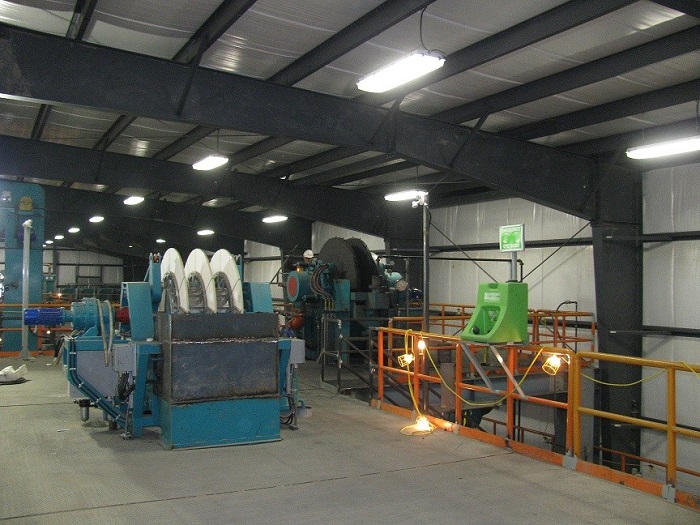
In effect the membrane forms a screen. In the early stages of separation across this membrane the solids deposit forming a second semi-permeable medium or cake. These two layers then form the filtering medium for the remainder of the slurry. The structure of the filtering cake changes continuously as more particles deposits with time. The main changes relate to permeability and porosity of the filtering zone. The permeability of the cake depends on the particle size, shape, thickness (depth) of solids and on the liquid properties, such as viscosity. The filtration rate is affected by differential pressure that is applied on the membrane to improve performance. Once a thick cake is formed the permeability decreases to the extent that the process is stopped. Filtration can continue by changing both the membrane and removing the deposited solids. The process of filtration is therefore essentially batch or continuous. Fig. 1 A shows the function of atypical filtering medium. Fig.1B is an enlargement of the semi-permeable medium. The figures show the mechanism of filtration where particles larger than the pore size are held back while the fluid passes through. Particles smaller than the pore space are also liable to pass through, but small particles existing away from the membrane surface may not be separated unless brought in contact with the membrane surface. Once the cake begins to build up, further filtration is continued through the deposited layer of solids as well as the medium. Therefore the permeability of both the filter cake and the medium is of paramount importance.
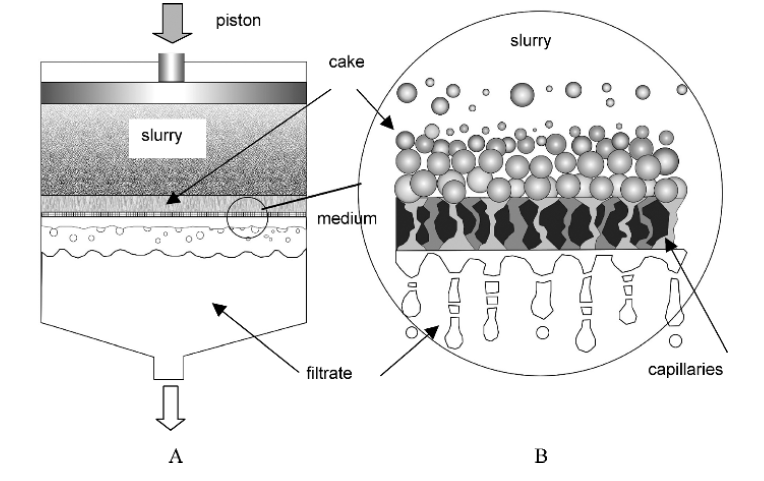
Fig1. Basic filtration setup
Most filter cakes can be compressed to varying degrees by pressure. In some cases, like a siliceous cake, limited packing can be achieved but in others like clayey deposits, compressibility may be high and application of pressure may result in appreciable reduction of permeability of the entire bed. The process of filtration is predominantly carried out at conditions of either constant pressure or constant volume flow rate.
The filtering process is completed when nearly all the liquid has been removed from the pulp and the filter cake is removed from the filtering medium. Before removing the cake, it can be washed to remove the adhering fluid, the fluid that is retained in the pore spaces in the cake and any solute in the feed that is entrapped within the cake.
The structure of the supporting base of the filtering medium is a guide to the nomenclature of filters in industry, Thus when the filtering medium is between grooved plates the filter press is known as plate filters, when it is in the form of disc they are known as disc filter, when in the form of a drum or continuous belt they are known as drum filters and horizontal belt filters. The method of application of pressure also contributes to the nomenclature, thus industrially they are known as pressure or vacuum filters. Several combinations of these options are practiced including constant rate or constant pressure filtration.
Chamber Filters
The Chamber filters are improved plate and frame filters (Fig. 2). These filters use recessed plates which when clamped together form chambers. The recess can be up to 25 mm. By recessing the plate, it forms its own frame and permits a thicker cake than the plate-and frame filters. The feed usually enters through a central port in the plate. The filtrate escapes through a manifold at the top. The other features of the filter plate are essentially similar to the plate and frame filters.
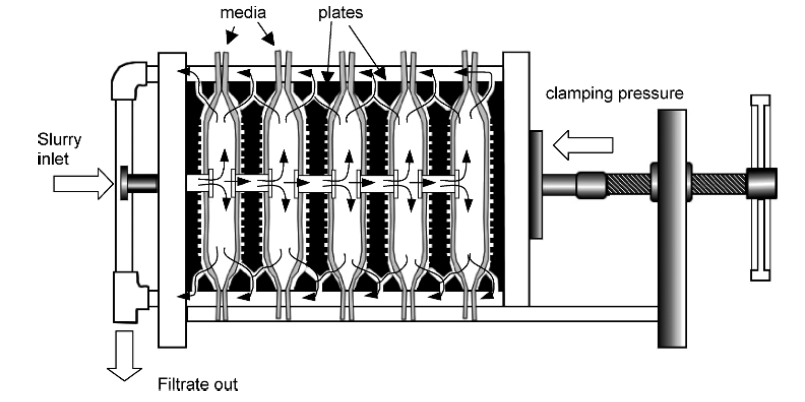
Fig2. Sketch of a Chamber Press filter
Chamber filters are usually designed to operate with a maximum of 153 plates with surface areas varying between 0.2 to 2.6 m per chamber.
The plates are connected to water lines for washing and to steam line for hot drying of the deposited cake. The cake is released from the medium by reversing the clamping device which is hydraulic or mechanical. Recessed plate filters are preferred where the cake is not very permeable, e.g., cakes produced on filtering slurries with excessive fine clays, or metallurgical slurries like in iron and alumina industries where the hydroxides have to be filtered.
Rotating Drum Filter
Rotating drum continuous filters consists of a horizontal drum with its bottom one-third section immersed in a tank of slurry that has to be filtered. The drum shell is perforated and covered with shallow compartments which serve as a drainage grid about 22 mm in depth.
The grid is covered with metal gauze which in turn is covered with the filtering cloth. The ends of the drum are either open or are closed with a spider through which the trunnion passes (Fig. 3). Each sector of the drum is connected from inside to a centrally located complex valve system. The valve has ports connected to vacuum, compressed air and water lines. Two of these rotate with the drum while the others are stationary. The valve acts in a manner such that the one third portion of the drum that is immersed in the slurry is under vacuum. The adjacent half of the drum is also under vacuum, but could be switched to dry air pressure. The remaining portion of the drum is under positive pressure which helps to dislodge the cake from the drum surface
In the first stage of the filtering cycle the filtrate is drawn into the drum leaving a cake of solids adhering to the medium surface. When the drum continues to rotate, the cake in the first segment emerges from the slurry and is exposed to the atmosphere. It can then be washed under vacuum to rinse the adhering solids. The drum then enters the drying section where the cake is dried by drawing air through it. On further rotation the drum enters the final zone where the cake is blown out using reversed air pressure and discharged.
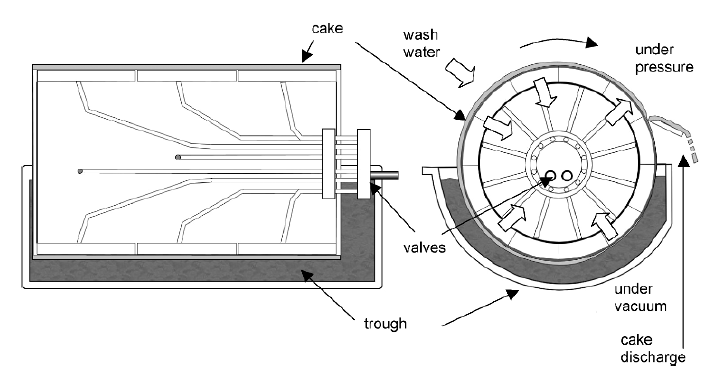
Fig3. Sketch of a Rotating Drum Filter
Rotating Disc Filter
The basic design characteristics of the rotating disc filter, like filtering under vacuum, washing the cake under vacuum and removing the cake by blowing the cake off the filter is the same as in the drum filter. Instead of one drum, a number of discs are placed in parallel.
The lower end of each disc is attached to a common horizontal pipe which passes through the centre of all the discs in the unit. The central pipe is designed to form the trunnion of the unit and serves as a conduit for the vacuum and pressure lines. The distance between the filters are fixed and this space is used to collect the cake off the filter surface. Each disk is designed to operate separately with its own slurry tank, thus more than one type of pulp can be filtered
simultaneously if required. Fig. 4 shows a sketch of a disc filter unit.
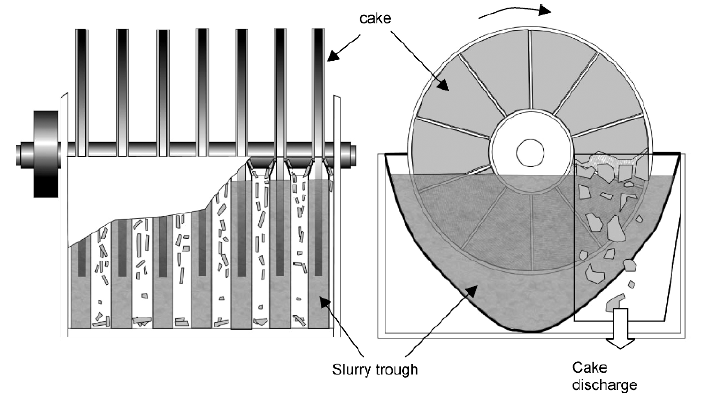
Fig4. Schematic diagram of a disc filter
Ceramic Disc Filters
The ceramic filter is a unique rotary disc filter which uses a sintered alumina disc to dewater a slurry under low vacuum. The dewatering occurs by drawing water from the slurry by capillary action. This ensures that no air or particles are drawn into the filter medium to cause blockage. Fig.5 shows a cross-section of the ceramic disc.
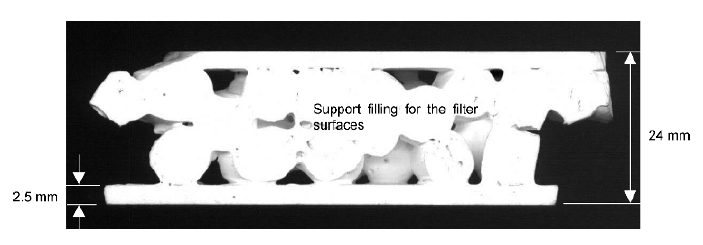
Fig 5. Cross-section of a 24 mm sintered alumina filtration disc
The low vacuum used in the filter removes the filtrate from the internal passages of the discs while the small pressure differential across the disc causes cake formation. A reduction of up to 90% in energy consumption is possible.
Horizontal Belt Vacuum Filter
Flat horizontal belt and Pan filters have been designed for fast settling and fast filtering slurries like iron ore concentrates. The Pan tilting vacuum filters are gradually getting out of use and therefore are not considered here. The horizontal filters are in the form of a continuous belt made of stainless or alloy steel and a medium in the form of a fabric network. The feed box is at one end of the belt which evenly spreads the slurry across the belt. The steel base of the travelling belt is covered by a rubber lining. The belt is stretched over two pulleys (Fig. 6). It is grooved so that the grooves are at right angles to the direction of movement. Between the pulleys the belt is flat and rectangular. The width of the belt of industrial units is usually 1-4 meter with a filtering area of up to 120 m2 for a 4 m x 30 m belt. Under the belt and between the pulleys is a vacuum box. The vacuum box has compartments that are adjustable along the length. Filtration takes place in the first compartment under vacuum and the filtrate is withdrawn from the bottom. In the second compartment the cake is washed under vacuum by co-current and counter current recycled wash water. Fresh make-up water is added at the last section. The wash waters are withdrawn also from the bottom under vacuum and the washed cake then dewatered and dried. Receivers for filtrate and wash waters are positioned under each section of the vacuum box.
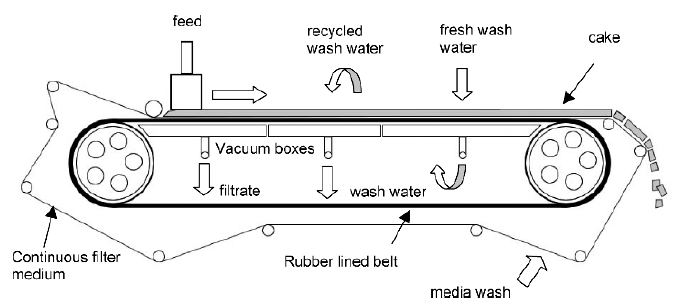
Fig6. Sketch of a continuous horizontal belt filter
Filtration in Mineral Processing Circuits
Filters and thickeners are usually integrated in series in the process plant. For example, placed in series with hydrocycloneoverflows and underflows and sometime following the filtration circuits, e.g in coal washeries, lead-zinc extraction plants, copper-lead-zinc circuits. A typical layout from a flotation circuit is shown in Fig.7. Several variations are seen in practice. As the filtration rates are relatively slower than most other unit operations constituting a mineral processing plant, several filtering units are placed in parallel to meet the production target.
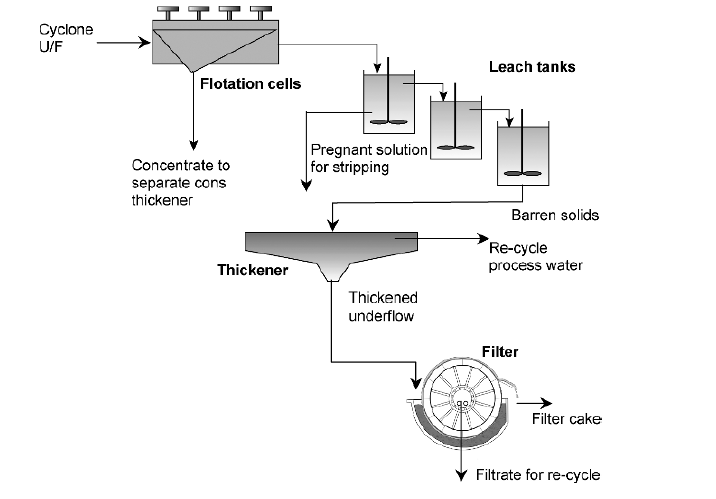
Fig7. Typical set-up of a filtration circuit